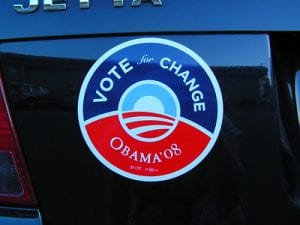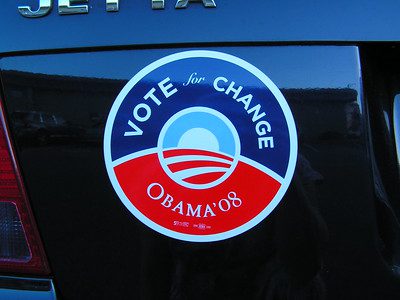
Photo by Michelle Ress for Flickr, CC BY-NC-ND 2.0
[Editor’s note: The links in this post to Barack Obama’s campaign position papers are no longer active. The Obama White House archives are here, and will have documents related to the issues discussed here. The link to the author’s blog archive is active as of March 2020.]
Here’s a little about what this week’s historic election may mean for smart growth, sustainable development, and metropolitan America, based on Barack Obama’s statements and literature. There is ample reason to believe that the president-elect has a better understanding of these issues than any other modern president.
The effect of land use on transportation & oil
First, his campaign’s position paper on energy on oil security and energy independence explicitly recognizes the benefits of smart growth.
“Over the longer term, we know that the amount of fuel we will use is directly related to our land use decisions and development patterns, much of which have been organized around the principle of cheap gasoline. Barack Obama believes that we must move beyond our simple fixation of investing so many of our transportation dollars in serving drivers and that we must make more investments that make it easier for us to walk, bicycle and access transportation alternatives.”
Importantly, Obama has also stressed that energy conservation should be made one of the explicit goals of the transportation planning required of metropolitan regions in order to secure federal dollars for roads, transit, and related projects. And he has indicated his support for leveling the tax subsidies afforded to employers who now may spend and deduct twice the amount, per employee, for automobile parking that they may spend on transit, carpooling or vanpooling.
Cities and rural areas
Moreover, the president-elect’s position paper on urban policy demonstrates in several places that he understands the connections between neighborhoods, cities, and metropolitan regions. For example, in a section on city livability, he stresses the importance of transportation alternatives, green buildings, and even that “how a community is designed – including the layout of its roads, buildings and parks – has a huge impact on the health of its residents.” In other sections, it stresses job creation in underserved areas and affordable housing.
For rural areas, his platform has included conservation of private lands, regional food networks, and help for organic farmers.
The new metropolitan reality
Beyond the campaign literature, Obama gave a major address to the U.S. Conference of Mayors in June, during which he showed that he gets it about the challenge of addressing growth at the metropolitan scale:
“The change that’s taking place today is as great as any we’ve seen in more than a century, since the time when cities grew upward and outward with immigrants escaping poverty, and tyranny, and misery abroad. Our population has grown by tens of millions in the past few decades, and it’s projected to grow nearly 50% more in the decades to come . . .”
(For more, please see my NRDC blog archive.)





Comments